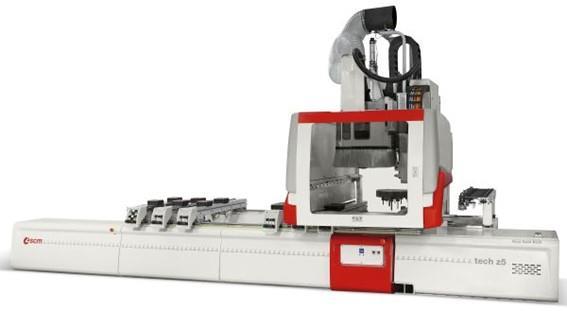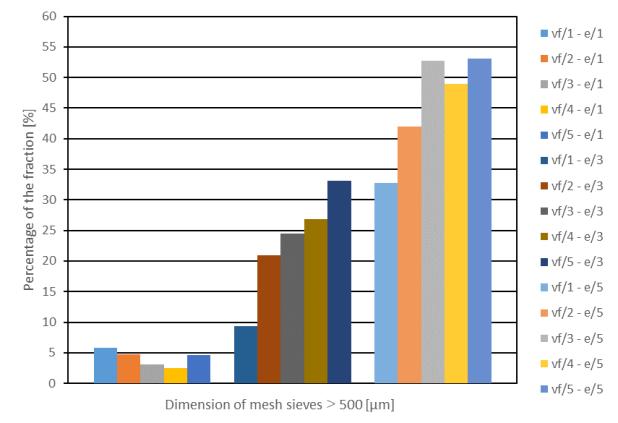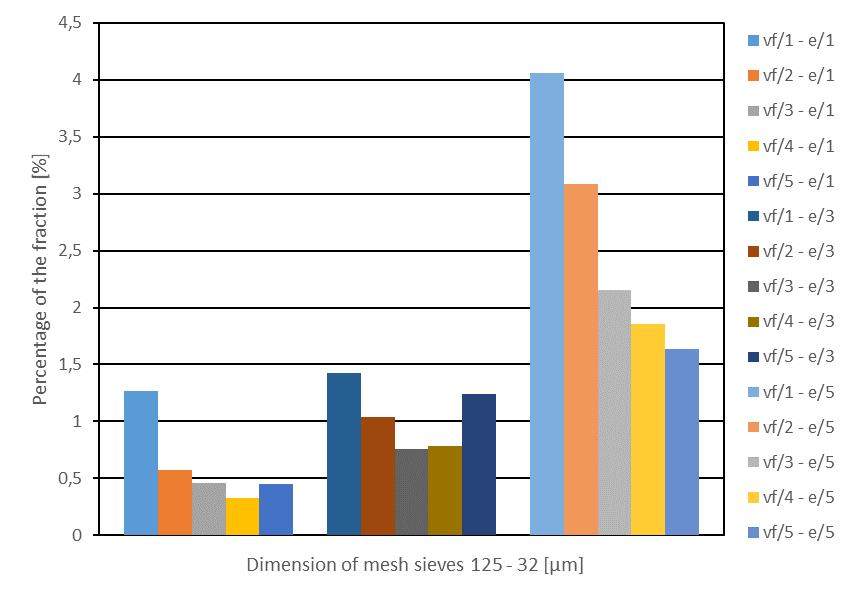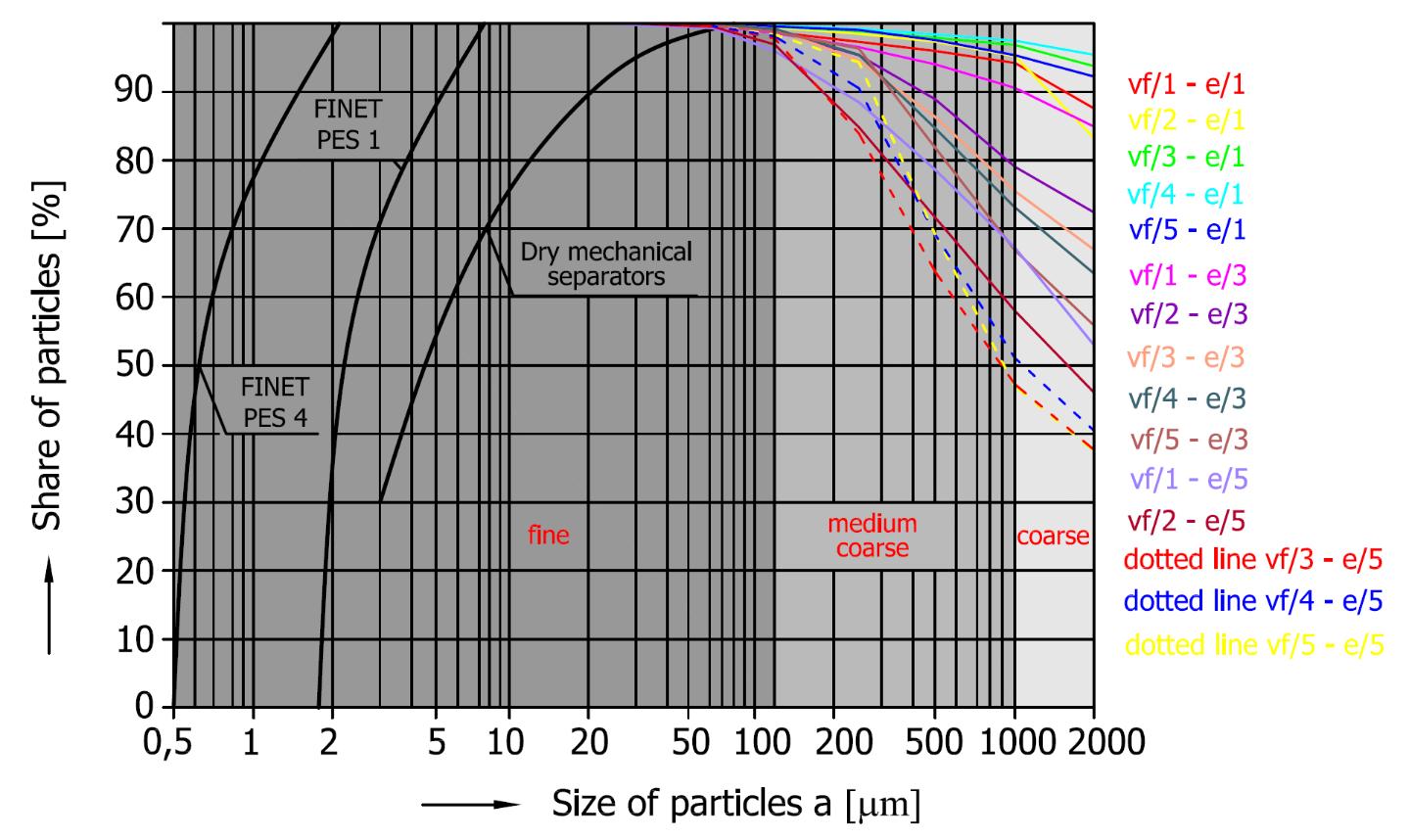
16 minute read
CHIPS FROM A CNC MACHINING CENTER ON THE ENVIRONMENTAL SEPARATION TECHNIQUE
ACTA FACULTATIS XYLOLOGIAE ZVOLEN, 64(1): 89−97, 2022 Zvolen, Technická univerzita vo Zvolene DOI: 10.17423/afx.2022.64.1.08
THE EFFECT OF THE GRANULOMETRIC COMPOSITION OF BEECH CHIPS FROM A CNC MACHINING CENTER ON THE ENVIRONMENTAL SEPARATION TECHNIQUE
Advertisement
Martin Kučerka - Alena Očkajová - Richard Kminiak - Marta Pędzik Tomasz Rogoziński
ABSTRACT
The aim of the paper is to determine the granulometric composition of chip removed from the beech lumber milling process using a CNC machining center SCM Tech Z5 in the range of commonly used technical and technological parameters under standard conditions of feed speed: vf = 1 ÷ 5 m.min-1 and the thickness of the removed layer: e = 1, 3 and 5 mm. Another goal of the paper was to select a suitable separation technique that would be sufficient to effectively capture the largest possible dispersion of fractions in the beech lumber milling process. Granulometric analysis showed that under the given conditions in the milling process the largest proportion of coarse and medium coarse fraction is formed and particles with a size smaller than 32 μm are not formed. For this reason, it is our recommendation to choose a combination of dry mechanical separators together with fabric filters, as mechanical separators are able to capture mainly larger particle fractions. Fabric filters would serve to trap any finer particles, thus saving the user from greater wear of the coarse and medium coarse fractions, which would increase the wear of the filter cloth to an increased extent. Key words: beech blanks, CNC machining center, granulometric composition of chips, separation ability
INTRODUCTION
Nowadays woodworking with CNC technologies is an integral part of the woodworking industry. The range of used CNC machines is very wide in the so-called CNC machining centers (KORČOK et al. 2018,KOS et al. 2004). Even with these modern computer controlled machines, we cannot avoid the problem of removing secondary material, which arises during machining - chip.
For conventional woodworking machines, it is relatively easy to design chip removal, as these tend to shape and move in the same way (OČKAJOVÁ et al. 2008, TUREKOVÁ et al. 2019, VANDLIČKOVÁ et al. 2020). Chip removal is more difficult when the working zone is large and the direction of relative movement between the tool and the workpiece is variable during machining, and this is another obstacle to chip removal efficiency (SEDLECKÝ 2017). This is the case in most CNC machines used in the woodworking industry (BARCÍK and GAŠPARÍK 2014, HLÁSKOVÁ et al. 2015, CANDELIER and DIBDIAKOVA 2021).
The efficiency of effective chip removal during milling in CNC machining centers depends on the type of operation performed in the CNC machining center, as well as on the machining path (PALUBICKI and ROGOZIŃSKI 2016, KOPECKÝ and ROUSEK 2006, PINKOWSKI et al. 2018,RAUTIO et al. 2007).
Nowadays as well as in the future, it is necessary to focus on reducing or eliminating hazardous substances in the workplace. Therefore, it is essential to look for ways to eliminate pollution in all industries, including wood. Thanks to the knowledge of the properties of the chip and its smallest particles in the form of dust, we are able to positively influence the development of separation techniques and technologies leading to the reduction of emissions in the working environment (HLÁSKOVÁ et al. 2018).
The separation of sawdust from the transport air is carried out using separation techniques such as mechanical separators of the SEA type series with T3/1600 cells, SEB type separators with T4/630 cells, and various fabric filters with dust particle permeability with dimensions below 3.5 μm (DZURENDA et al. 2008). Separators SEA and SEB are used to separate coarse and medium coarse particles such as sawdust, shavings, chips, etc. (DZURENDA 2002). Fabric filters with filter fabrics made of FINET-PES materials are more suitable for extracting finer and fibrous chip fraction. The optimal technical solution of the air-conditioning system and the conditions of the separation of sawdust from the transport air is conditioned, among other things, by taking into account the knowledge about the physical properties, grain size and geometric shapes of the chips of the extracted loose wood mass (MRAČKOVÁ et al. 2016,OČKAJOVÁ et al. 2010, DREVKO et al. 2005).
The aim of this paper is to obtain information on the granulometric composition of chips generated during milling in a CNC machining center, in different material removal settings, when using different feed speeds, when machining native beech wood. The constructed residue curves for individual variants of the obtained chips suggest a possible separation technique.
MATERIALS AND METHODS
Characteristics of the material used: in the experiment, furniture blanks made of beech wood (Fagus sylvatica L.) of the following dimensions were used: length l = 500 mm (± 1 mm), width w = 80 mm (± 0.5 mm), thickness h = 50 mm (± 0.5 mm). The cut orientation within the thickness was radial. The moisture content of the blanks was determined to w = 10 % (± 2 %).
Characteristics of the machinery used: the experiment was carried out using a 5-axis CNC machining center SCM Tech Z5 (Figure 1) supplied by SCM-group, Rimini, Italy. The basic technical-technological parameters given by the manufacturer are provided in Table 1. The experiment used a single-knife end mill with type designation KARNED 4451 from the manufacturer Karned Tools s.r.o., Prague, Czech Republic with a working diameter d = 16 mm. The reversible knife HW 49.5/9 /1.5 made of sintered carbide T10MG was fitted in the end mill.
Fig. 1 CNC machining center SCM Tech Z5.
Tab. 1 Technical and technological parameters of the CNC machining center SCM Tech Z5.
Technical parameters of the CNC machining center SCM tech Z5
Useful desktop Speed in the X axis Speed in the Y axis Speed in the Z axis Vector speed
Rotation axis C X = 3 050 mm, Y = 1 300 mm, Z = 3 00 mm 0 ÷ 70 m.min-1 0 ÷ 40 m.min-1 0 ÷ 15 m.min-1 0 ÷ 83 m.min-1
The parameters of the main spindle Electric spindle with connection HSK F63 640°
Rotation axis B Speed Power 320° 600 ÷ 24 000 ot.min-1 11 kW – 24 000 ot.min-1 7.5 kW – 10 000 ot.min-1
Maximum tool size D = 160 mm L = 180 mm
The course of the experiment: the workpiece was milled with a KARNED 4451 end mill under the following conditions: removal e = 1, 3, 5 mm, milling speed n = 20 000 rpm, feed speed vf = 1 ÷ 5 m.min-1 . For each parameter combination 6 samples were milled. Samples for granulometric analysis of wood dust were taken isokinetically from the exhaust pipe of the CNC woodworking center in accordance with STN 9096: 2021 (83 4610): "Manual determination of the mass concentration of solid pollutants". The granulometric composition of the chip was determined by sieving. For this purpose, a special set of stacked screens (2 mm, 1 mm, 0.5 mm, 0.25 mm, 0.125 mm, 0.063 mm, 0.032 mm and bottom) placed on a vibrating stand of a Retsch AS 200c screening machine from the company was used Retsh GmbH, Haan, Germany. The sieving parameters were in accordance with STN 153105 and STN ISO 3310-1, sieve interruption frequency 20 seconds, sieve amplitude 2 mm.g -1, sieving time τ = 15 minutes, weighing 50 g. The granulometric composition was obtained by considering the proportions remaining on the sieves after sieving on a Radwag 510/C /2 electric laboratory balance from Radwag Balances and Scales, Radom, Poland, with a weighing accuracy of 0.001 g. Screening was performed on three samples for each combination of parameters.
RESULTS AND DISCUSSION
In the experiment, the conditions were identical to those in the furniture manufacturing practice. Chip removal was set at 1, 3 and 5 mm. Commonly used feed speed when processing grown wood is 1, 2, 3, 4 and 5 m.min-1. The results of the average values of the sieve analyzes in combination with the feed speeds and the chip removal are shown in Table 2.
Tab. 2 Granulometric composition of beech chips from the milling process on a CNC machining.
Thickness of removed layer e [mm] Dimension of mesh sieves [μm]
Fraction designation Percentage of the fraction [%] Feed speed vf [m.min-1]
1 mm
3 mm
5 mm 2 mm 1 mm coarse
1 m.min-1
2 m.min-1
3 m.min-1
4 m.min-1
5 m.min-1
87.60 83.27 93.77 95.43 92.24 6.63 11.97 3.09 2.05 3.13
500 μm 250 μm 125 μm medium coarse 63 μm 32 μm ˂ 32 μm fine
2 mm 1 mm coarse 1.75 2.11 1.04 0.92 2.22 1.34 1.16 0.98 0.81 1.46 1.41 0.92 0.66 0.47 0.5 1.01 0.42 0.34 0.28 0.36 0.26 0.15 0.12 0.04 0.09 0 0 0 0 0 84.94 72.39 66.94 63.47 55.86 5.65 6.65 8.56 9.65 10.98
500 μm 250 μm 125 μm 63 μm 32 μm ˂ 32 μm medium coarse
fine 3.43 9.89 10.87 11.58 15.04 2.52 6.42 8.22 10.73 14.45 2.04 3.61 4.66 3.79 2.43 1.10 0.84 0.58 0.62 0.97 0.32 0.2 0.17 0.16 0.27 0 0 0 0 0
2 mm coarse
52.98 46.06 37.70 40.49 37.51 1 mm 14.25 11.92 9.54 10.60 9.44 500 μm medium coarse 11.41 13.68 16.50 18.11 22.26 250 μm 9.85 13.18 20.19 21.34 25.12 125 μm 7.46 12.08 13.91 7.60 4.04 63 μm 3.40 2.61 1.76 1.48 1.26
32 μm fine 0.65 0.47 0.40 0.38 0.37
˂ 32 μm 0 0 0 0 0
The results shown in the table show that chips with dimensions over 2 mm have the highest percentage. We classify these chips in the category of so-called flat chips this means that the length and width of the chip are significantly greater than its thickness. With greater chip removal and with increasing feed speed, the proportion of flat chips decreases. A smaller chip removal results in a higher proportion of fractions with dimensions above 2 mm, because the chip has the shape of a cut layer of milled wood and is solid and without bends. Fractions below 500 μm (medium coarse fraction) can already be characterized as isometric chips i.e., chips which have approximately the same dimensions in all three directions. The proportion of these fractions increases significantly with increasing material removal, from 2.2 % at a removal of 1 mm and a feed speed of 4 m.min-1, to 51.42 % at a removal of 5 mm and feed speed of 5 m.min-1. The highest proportion of dust inhalable chip
fractions (with dimensions below 63 μm) arises at higher material removal, at 5 mm removal it is up to 12.78 % compared to 1 mm material removal, where it is 3.07 % and at 3 mm removal it is 5.23 %. Thus, we can say that with increasing thickness of the cut layer, the proportion of medium coarse and fine chip fractions increases independently of the feed speed, which he also confirmed (KMINIAK and BANSKI 2018) in a similar experiment for oak lumber. From the point of view of feed speeds, the fact was confirmed that at a higher feed speed and at a thickness of the cut layer of 3 mm the proportion of medium coarse fraction increases, at a cut layer thickness of 5 mm the share of fine particles gradually increased with increasing feed speed. This statement was also confirmed by the authors (SIKLIENKA et al. 2017, LISIČAN 1996) who claim that increasing the thickness of the cut layer as well as the feed speed breaks up the fractions and increases the proportion of medium-coarse and fine fractions. On the contrary, an increase in the feed speed results in a decrease in the proportion of the fraction above 2 mm.
During the wood milling process using the CNC machining center, we can declare that the machining center we used does not produce respirable fractions with dimensions below 32 μm. These fractions are especially respirable if they are in the air. Similar results were obtained on a conventional bottom spindle milling machine for oak and spruce milling (OČKAJOVÁ et al.2020).
From the histogram in Fig. 2, it is clear that the proportion of all fractions smaller than 500 μm increases with increasing thickness of the cut layer, from a minimum of 2.52 % at the smallest cut layer thickness to 53.05 % at the highest feed speed and the largest thickness truncated layer. If we divide it into a medium coarse and a fine fraction, we can see that with a medium coarse fraction (particles with a size of 500 - 125 μm) the proportion of particles increases with increasing thickness of the cut layer and in most cases with increasing feed speed. In the case of a fine fraction (particles with dimensions of 125 - 32 μm), at the highest thickness of the cut layer and in this case also with gradually increasing feed speed, the proportion of particles decreases and therefore we can say that these parameters no longer were at a thickness of the cut layer of 1 and 3 mm. Similar results were confirmed by the authors (KMINIAK and BANSKI 2018).

Fig. 2 Comparison of granulometric composition of coarse fraction chips.

Fig. 3 Comparison of granulometric composition of medium coarse chips.
Fig. 4 Comparison of granulometric composition of fine fraction chips.

We also evaluated the obtained results of sieve analyzes using residue curves, which clearly present the proportions of individual fractions, and we supplemented them with curves for dry mechanical separators and filter fabrics. In conclusion, we recommend the use of dry mechanical separators in combination with fabric filters to capture these fractions (KMINIAK et al. 2020). This combination is suitable due to the capture of larger coarse and medium coarse fractions by dry mechanical separators (at the level of 80 µm) and subsequent capture of finer fractions by fabric filters, which would significantly reduce the wear of fabric filters against abrasion from larger coarse and medium coarse fractions.

Fig. 5 Comparison of curves of residual chips at individual milling parameters with dry mechanical separators and filter fabrics.
CONCLUSION
By granulometric analysis, we found that under the given conditions in the milling process, the largest share of the coarse fraction over 500 μm with a thickness of the cut layer of 1 mm is formed. As the thickness of the layer to be cut increases, the proportion of the coarse fraction decreases and the proportion of the medium coarse fraction increases and, to a lesser extent, the proportion of the fine fractions at different slidin speeds. On the contrary, at the highest thickness of the cut layer (5 mm) and with a gradually increasing feed speed, the proportion of fine particles with a size of 125 - 32 μm decreases. We can state that the given process does not produce particles smaller than 32 μm, which means that dry mechanical separators in combination with fabric filters will be sufficient to capture even smaller fines from another woodworking process.
REFERENCES
BANSKI A., KMINIAK R. 2018. Influence of the thickness of removed layer on granulometric composition of chips when milling oak blanks on the CNC machining center. In Trieskové a beztrieskové obrábanie dreva [Chip and chipless woodworking], 11(1), 23-30. ISSN 2453-904X. BARCÍK, Š., GAŠPARÍK, M. 2014. Effect of Tool and Milling Parameters on the Size Distribution of Splinters of Planed Native and Thermally Modified Beech Wood. In BioResources, 9(1): 1346-1360. CANDELIER, K., DIBDIAKOVA, J. 2021. A review on life cycle assessments of thermally modified wood. In Holzforschung, vol. 75, no. 3, 2021, pp. 199-224. DOI:10.1515/hf-2020-0102 DREVKO, S., MAČALA, J., BAKALÁR, T. 2005. Analýza fyzikálnych vlastností látkových filtrov [Analysis of physical properties of fabric filters]. In Acta Montanistica Slovaca, 10(1), 204-208. DZURENDA L., 2002. Vzduchotechnická doprava a separácia dezintegrovanej drevnej hmoty [Air transport and separation of disintegrated wood]. Technical university in Zvolen, 143 p. ISBN 80228-1212-9.
HLÁSKOVÁ,L.,ROGOZIŃSKI,T.,DOLNY,S.,KOPECKÝ,Z.,JEDINÁK,M.2015.Content of respirable and inhalable fractions in dust created while sawing beech wood and its modifications. In DrewnoWood: Prace naukowe, doniesienia, komunikaty 58(194): 135-146. HLÁSKOVÁ, L., ORLOWSKI, K. A., KOPECKÝ, Z., SVITÁK, M., OCHRYMIUK, T. 2018. Fracture toughness and shear yield strength determination for two selected species of central European Provenance. In BioResources, 13(3): 6171-6186. DOI: 10.15376/biores.13.3.6171-6186 KMINIAK,R.,ORLOWSKI,K.A.,DZURENDA,L.,CHUCHALA,D.,BANSKI,A.2020. Effect of Thermal Treatment of Birch Wood by Saturated Water Vapor on Granulometric Composition of Chips from Sawing and Milling Processes from the Point of View of Its Processing to Composites. In Applied Sciences 10, no. 21: 7545. DOI: 10.3390/app10217545 KOPECKÝ Z., ROUSEK M. 2006. Simulation possibilities of dust emission in high-speed milling. 1st Jubilee Scientific Conference Manufacturing Engineering in Time of Information Society. Gdansk: Gdansk University of Technology, 191-196. KORČOK, M., KOLEDA, P., BARCÍK, Š., VANČO, M. 2018. Effects of Technical and Technological Parameters on the Surface Quality when Milling Thermally Modified European Oak Wood. In BioResources, 13(4): 8569-8577. KOS, A., BELJO-LUČIĆ, R., ŠEGA, K., RAPP, A. O. 2004. Influence of woodworking machine cutting parameters on the surrounding air dustiness. In Holz als Roh-und Werkstoff 62(3): 169-176. DOI: 10.1007/s00107-004-0473-2 LISIČAN, J. 1996. Theory and technique of wood working. Zvolen: MAT-CENTRUM, Slovakia. MRAČKOVÁ, E., KRIŠŤÁK, Ľ., KUČERKA, M., GAFF, M., GAJTANSKA, M. 2016. Creation of Wood Dust during Wood Processing: Size Analysis, Dust Separation, and Occupational Health. In BioResources, 11(1): 209-222. OČKAJOVÁ,A.,BELJAKOVÁ,A.,SIKLIENKA,M.2010. Morphology of dust particles from the sanding process of the chosen tree species. In Wood research. Bratislava: Paper and Pulp Research Institute, 55(2): 89-98, ISSN 1336-4561. OČKAJOVÁ, A., BELJAKOVÁ, A., LUPTÁKOVÁ, J. 2008. Selected properties of spruce dust generated from sanding operations. In Drvna industrija, 59(1): 3-10. OČKAJOVÁ, A., KUČERKA, M., KMINIAK, R., ROGOZIŃSKI, T. 2020. Granulometric composition of chips and dust produced from the process of working thermally modified wood. In Acta Facultatis Xylologiae Zvolen, 62(1): 103-111. DOI: 10.17423/afx.2020.62.1.09 PAŁUBICKI, B., ROGOZIŃSKI, T. 2016. Efficiency of chips removal during CNC machining of particleboard. In Wood research. Bratislava: Paper and Pulp Research Institute, 61(5):811-818, ISSN 1336-4561. PINKOWSKI, G., SZYMAŃSKI, W., KRAUSS, A., STEFANOWSKI, S. 2018. The effect of the feed speed and rotation speed of plane milling on the surface roughness of beech wood. In Annals WULSSGGW, For. and Wood Technol 103, 5-12. RAUTIO, S., HYNYNEN, P., WELLING, I., HEMMILA, P., USENIUS, A., NARHI, P. 2007. Modelling of airborne dust emissions in CNC MDF milling. In Holz als Roh-und Werkstoff 65(5): 335-341. DOI: 10.1007/s00107-007-0179-3 SEDLECKÝ, M. 2017. Surface Roughness of Medium-Density Fiberboard (MDF) and Edge-Glued Panel (EGP) After Edge Milling. In BioResources, 12(4): 8119-8133. DOI: 10.15376/biores.12.4.8119-8133 SIKLIENKA, M., KMINIAK, R., ŠUSTEK, J., JANKECH, A. 2017. Delenie a obrábanie dreva. Zvolen: Technická univerzita vo Zvolene, p. 357. ISBN 80-228-2845-1. TUREKOVÁ I, MRAČKOVÁ E, MARKOVÁ I. 2019. Determination of Waste Industrial Dust Safety Characteristics. In International Journal of Environmental Research and Public Health 16(12):2103. DOI: 10.3390/ijerph16122103
VANDLIČKOVÁ M,MARKOVÁ I,MAKOVICKÁ OSVALDOVÁ L,GAŠPERCOVÁ S,SVETLÍK J,VRANIAK J. 2020. Tropical Wood Dusts - Granulometry, Morfology and Ignition Temperature. Applied Sciences 10(21):7608. DOI: 10.3390/app10217608
STN ISO 9096 (83 4610): 2021. Ochrana ovzdušia. Stacionárne zdroje znečisťovania. Manuálne stanovenie hmotnej koncentrácie tuhých znečisťujúcich látok [Air protection. Stationary sources of pollution. Manual determination of the mass concentration of solid pollutants]. STN 1531 05/ STN ISO 3310-1: 2000. Súbor sít na laboratórne účely [A set of sieves for laboratory purposes].
ACKNOWLEDGMENT
This work was support by the grant agency VEGA under the project No. 1/0324/21 and KEGA under the project No. 026UMB-4/2021. This publication is also the result of the project implementation: Progressive research of performance properties of wood-based materials and products (LignoPro), ITMS: 313011T720 (10%) supported by the Operational Programme Integrated Infrastructure (OPII) funded by the ERDF.
AUTHORS’ ADDRESSES
Ing. Martin Kučerka, PhD., prof. Ing. Alena Očkajová, PhD. Matej Bel University in Banská Bystrica Faculty of Natural Sciences Department of Technology Tajovského 40 974 01 Banská Bystrica Slovakia martin.kucerka@umb.sk; alena.ockajova@umb.sk
doc. Ing. Richard Kminiak, PhD. Technical University in Zvolen Faculty of Wood Sciences and Technology Department of Woodworking T. G. Masaryka 2117/24 Slovakia richard.kminiak@tuzvo.sk
Marta Pedzik Poznań University of Life Sciences Faculty of Wood Technology Wojska Polskiego 38/42 60-627 Poznań Poland marta.pedzik@itd.lukasiewicz.gov.pl
Dr. hab. Tomasz Rogoziński Poznań University of Life Sciences Faculty of Wood Technology Wojska Polskiego 38/42 60-627 Poznań Poland trogoz@up.poznan.pl
98









